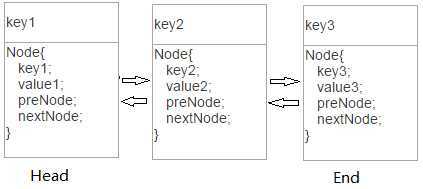标签:key use map refresh 数据库查询 com return 问题 under
随着公司的业务越来越复杂,需要提供一个用户系统,供各个业务系统来查询用户的基本信息。且业务方对用户信息的查询频率很高,设计的用户系统需要注意性能。
在LRU算法中,使用一种叫作“哈希链表”的数据结构。哈希表由若干个key-value组成,逻辑上这些key-value是无所谓排序的。但在哈希链表中,这些key-value被一个链条串在一起,不再是无序的了,而是有 了固定的排列顺序。每一个key-value都有前驱key-value、后继key-value。所以我们可以把key-value按照最后使用的时间来进行排序。链表的尾部是最近被使用的,头部是最近被使用最少甚至没有被使用过的key-value。所以,当缓存容量达到上限时,会先删除链表最左端的值,再把新的值插入到链表的最右端。
哈希链表的结构:

注意点: 删除节点的同时,记得把节点的key也要从hashMap中删除
1 package blogSrc; 2 3 import java.util.HashMap; 4 5 public class LRUCache { 6 private Node head; 7 private Node end; 8 9 private HashMap<String,Node> hashMap; 10 private int limit; //缓存上限 11 12 public LRUCache(int limit){ 13 this.limit = limit; 14 this.hashMap = new HashMap<String,Node>(); 15 } 16 17 //向链表中添加节点 18 public void addNode (Node node){ 19 if (head == null){ //空链 20 head = node; 21 } 22 23 if(end != null) { //节点添加到尾部 24 end.next = node; 25 node.pre = end; 26 node.next = null; 27 } 28 end = node; 29 } 30 31 //从链表中移除节点 32 public String removeNode(Node node){ 33 if(head == end && node == head){ //链表只有一个节点 34 head = null; 35 end = null; 36 }else if (node == end){ //node为最后一个节点 37 end.pre.next = null; 38 end = end.pre; 39 }else if (node == head){ //node为第一个节点 40 head.next.pre = null; 41 head = head.next; 42 }else { //node为中间节点 43 node.pre.next = node.next; 44 node.next.pre = node.pre; 45 } 46 return node.key; 47 } 48 49 //刷新链表,将最近使用的节点放置到链表末尾 50 public void refreshNode(Node node){ 51 if (node == end){ 52 return; 53 } 54 removeNode(node); //删除节点 55 addNode(node); //添加节点 56 } 57 58 //根据节点的key值,获取链表中该节点的value值 59 public String get(String key){ 60 Node node = hashMap.get(key); 61 if (node == null){ 62 return null; 63 } 64 refreshNode(node); 65 return node.value; 66 } 67 68 //向链表上添加key-value 69 public void put(String key, String value){ 70 Node node = hashMap.get(key); 71 if (node == null){ 72 if (hashMap.size() >= limit){ 73 String oldKey = removeNode(head); //删除节点 74 hashMap.remove(oldKey); //同时需要把节点的key也从hashmap中删除 75 } 76 node = new Node(key,value); 77 addNode(node); 78 hashMap.put(key,node); 79 }else { 80 node.value = value; 81 refreshNode(node); 82 } 83 } 84 85 //从链表上删除指定key的数据 86 public void remove(String key){ 87 Node node = hashMap.get(key); 88 if (node == null){ 89 return ; 90 } 91 removeNode(node); 92 hashMap.remove(key); 93 } 94 95 class Node { 96 public Node next; 97 public Node pre; 98 public String key; 99 public String value; 100 Node(String key, String value){ 101 this.key = key; 102 this.value = value; 103 } 104 105 public String getNextKey() { 106 return next.getKey(); 107 } 108 109 public String getPreKey() { 110 return pre.getKey(); 111 } 112 113 public String getKey() { 114 return key; 115 } 116 117 public String getValue() { 118 return value; 119 } 120 } 121 122 123 public static void main(String[] args){ 124 LRUCache lruCache = new LRUCache(10); 125 lruCache.put("001","用户1信息"); 126 lruCache.put("002","用户2信息"); 127 lruCache.put("003","用户3信息"); 128 lruCache.put("004","用户4信息"); 129 lruCache.get("003"); 130 System.out.println("Now End Node Key is: " + lruCache.end.getKey()+ ",Value is: " +lruCache.end.getValue()); 131 lruCache.put("002","用户2信息更新"); 132 System.out.println("Now End Node Key is: " + lruCache.end.getKey() + ",Value is: " +lruCache.end.getValue() ); 133 lruCache.put("006","用户6信息"); 134 System.out.println("Now End Node Key is: " + lruCache.end.getKey()+ ",Value is: " +lruCache.end.getValue()); 135 } 136 }
结果:
Now End Node Key is: 003,Value is: 用户3信息 Now End Node Key is: 002,Value is: 用户2信息更新 Now End Node Key is: 006,Value is: 用户6信息
标签:key use map refresh 数据库查询 com return 问题 under
原文地址:https://www.cnblogs.com/zldmy/p/11568544.html